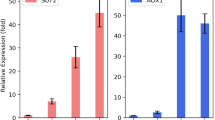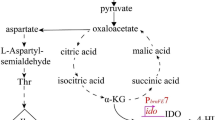Abstract
Regulation of amino acid metabolism (RAM) domains are widely distributed among prokaryotes. In most cases, a RAM domain fuses with a DNA-binding domain to act as a transcriptional regulator. The extremely thermophilic bacterium, Thermus thermophilus, only carries a single gene encoding a RAM domain-containing protein on its genome. This protein is a stand-alone RAM domain protein (SraA) lacking a DNA-binding domain. Therefore, we hypothesized that SraA, which senses amino acids through its RAM domain, may interact with other proteins to modify its functions. In the present study, we identified anthranilate phosphoribosyltransferase (AnPRT), the second enzyme in the tryptophan biosynthetic pathway, as a partner protein that interacted with SraA in T. thermophilus. In the presence of tryptophan, SraA was assembled to a decamer and exhibited the ability to form a stable hetero-complex with AnPRT. An enzyme assay revealed that AnPRT was only inhibited by tryptophan in the presence of SraA. This result suggests a novel feedback control mechanism for tryptophan biosynthesis through an inter-RAM domain interaction in bacteria.






Similar content being viewed by others
Abbreviations
- PCR:
-
Polymerase chain reaction
- SDS-PAGE:
-
Sodium dodecyl sulfate-polyacrylamide gel electrophoresis
- qRT-PCR:
-
Quantitative reverse transcriptase polymerase chain reaction
- RAM domain:
-
Regulation of amino acid metabolism domain
- Lrp:
-
Leucine-responsive regulatory protein
- AS:
-
Anthranilate synthase
- AnPRT:
-
Anthranilate phosphoribosyltransferase
- PRPP:
-
Phosphoribosylpyrophosphate
References
Bae YM, Crawford IP (1990) The Rhizobium meliloti trpE(G) gene is regulated by attenuation, and its product, anthranilate synthase, is regulated by feedback inhibition. J Bacteriol 172:3318–3327
Belser WL, Murphy JB, Delmer DP, Mills SE (1971) End product control of tryptophan biosynthesis in extracts and intact cells of the higher plant Nicotiana tabacum var. Wisconsin 38. Biochim Biophys Acta 237:1–10
Brinkman AB, Bell SD, Lebbink RJ, de Vos WM, van der Oost J (2002) The Sulfolobus solfataricus Lrp-like protein LysM regulates lysine biosynthesis in response to lysine availability. J Biol Chem 277:29537–29549
Brinkman AB, Ettema TJ, de Vos WM, van der Oost J (2003) The Lrp family of transcriptional regulators. Mol Microbiol 48:287–294
Caligiuri MG, Bauerle R (1991) Identification of amino acid residues involved in feedback regulation of the anthranilate synthase complex from Salmonella typhimurium. Evidence for an amino-terminal regulatory site. J Biol Chem 266:8328–8335
Cava F, Hidalgo A, Berenguer J (2009) Thermus thermophilus as biological model. Extremophiles 13:213–231
Chipman DM, Shaanan B (2001) The ACT domain family. Curr Opin Struct Biol 11:694–700
Enoru-Eta J, Gigot D, Thia-Toong TL, Glansdorff N, Charlier D (2000) Purification and characterization of Sa-lrp, a DNA-binding protein from the extreme thermoacidophilic archaeon Sulfolobus acidocaldarius homologous to the bacterial global transcriptional regulator Lrp. J Bacteriol 182:3661–3672
Ernsting BR, Atkinson MR, Ninfa AJ, Matthews RG (1992) Characterization of the regulon controlled by the leucine-responsive regulatory protein in Escherichia coli. J Bacteriol 174:1109–1118
Ettema TJ, Brinkman AB, Tani TH, Rafferty JB, Van Der Oost J (2002) A novel ligand-binding domain involved in regulation of amino acid metabolism in prokaryotes. J Biol Chem 277:37464–37468
Fujita A, Misumi Y, Honda S, Sato T, Koyama Y (2013) Construction of new cloning vectors that employ the phytoene synthase encoding gene for color screening of cloned DNA inserts in Thermus thermophilus. Gene 527:655–662
Grant GA (2006) The ACT domain: a small molecule binding domain and its role as a common regulatory element. J Biol Chem 281:33825–33829
Grove TH, Levy HR (1975) Fluorescent assay of anthranilate synthetase-anthranilate 5-phosphoribosylpyrophosphate phosphoribosyltransferase enzyme-complex on polyacrylamide gels. Anal Biochem 65:458–465
Heery DM, Dunican LK (1993) Cloning of the trp gene cluster from a tryptophan-hyperproducing strain of Corynebacterium glutamicum: identification of a mutation in the trp leader sequence. Appl Environ Microbiol 59:791–799
Henderson EJ, Nagano H, Zalkin H, Hwang LH (1970) The anthranilate synthetase-anthranilate 5-phosphoribosylpyrophosphate phosphoribosyltransferase aggregate. Purification of the aggregate and regulatory properties of anthranilate synthetase. J Biol Chem 245:1416–1423
Henne A, Bruggemann H, Raasch C et al (2004) The genome sequence of the extreme thermophile Thermus thermophilus. Nat Biotechnol 22:547–553
Hove-Jensen B (1989) Phosphoribosylpyrophosphate (PRPP)-less mutants of Escherichia coli. Mol Microbiol 3:1487–1492
Jackson EN, Yanofsky C (1974) Localization of two functions of the phosphoribosyl anthranilate transferase of Escherichia coli to distinct regions of the polypeptide chain. J Bacteriol 117:502–508
Knoten CA, Hudson LL, Coleman JP, Farrow JM, Pesci EC (2011) KynR, a Lrp/AsnC-type transcriptional regulator, directly controls the kynurenine pathway in Pseudomonas aeruginosa. J Bacteriol 193:6567–6575
Koyama Y, Hoshino T, Tomizuka N, Furukawa K (1986) Genetic-transformation of the extreme thermophile Thermus thermophilus and of other Thermus spp. J Bacteriol 166:338–340
Matsui K, Miwa K, Sano K (1987) Two single-base-pair substitutions causing desensitization to tryptophan feedback inhibition of anthranilate synthase and enhanced expression of tryptophan genes of Brevibacterium lactofermentum. J Bacteriol 169:5330–5332
Morollo AA, Eck MJ (2001) Structure of the cooperative allosteric anthranilate synthase from Salmonella typhimurium. Nat Struct Biol 8:243–247
Nakamura A, Takakura Y, Kobayashi H, Hoshino T (2005) In vivo directed evolution for thermostabilization of Escherichia coli hygromycin B phosphotransferase and the use of the gene as a selection marker in the host-vector system of Thermus thermophilus. J Biosci Bioeng 100:158–163
Nakano N, Okazaki N, Satoh S, Takio K, Kuramitsu S, Shinkai A, Yokoyama S (2006) Structure of the stand-alone RAM-domain protein from Thermus thermophilus HB8. Acta Crystallogr F 62:855–860
O’Gara JP, Dunican LK (1995) Mutations in the trpD gene of Corynebacterium glutamicum confer 5-methyltryptophan resistance by encoding a feedback-resistant anthranilate phosphoribosyltransferase. Appl Environ Microbiol 61:4477–4479
Okamura H, Yokoyama K, Koike H, Yamada M, Shimowasa A, Kabasawa M, Kawashima T, Suzuki M (2007) A structural code for discriminating between transcription signals revealed by the feast/famine regulatory protein DM1 in complex with ligands. Structure 15:1325–1338
Peeters E, Charlier D (2010) The Lrp family of transcription regulators in archaea. Archaea 2010:750457
Sambrook JF, Fritsch EF, Maniatis T (1989) Molecular cloning: a laboratory manual, 2nd edn. Cold Spring Harbor Laboratory Press, Cold Spring Harbor New York
Song N, Cui Y, Li Z, Chen L, Liu S (2016) New Targets and cofactors for the transcription factor LrpA from Mycobacterium tuberculosis. DNA Cell Biol 35:167–176
Sugimoto S, Shiio I (1983) Regulation of tryptophan biosynthesis by feedback inhibition of the 2nd-step enzyme, anthranilate phosphoribosyl-transferase, in Brevibacterium flavum. Agric Biol Chem 47:2295–2305
Tanaka T, Kawano N, Oshima T (1981) Cloning of 3-isopropylmalate dehydrogenase gene of an extreme thermophile and partial-purification of the gene-product. J Biochem (Tokyo) 89:677–682
Tutino ML, Tosco A, Marino G, Sannia G (1997) Expression of Sulfolobus solfataricus trpE and trpG genes in E. coli. Biochem Biophys Res Commun 230:306–310
Yokoyama K, Ishijima SA, Koike H, Kurihara C, Shimowasa A, Kabasawa M, Kawashima T, Suzuki M (2007) Feast/famine regulation by transcription factor FL11 for the survival of the hyperthermophilic archaeon Pyrococcus OT3. Structure 15:1542–1554
Acknowledgements
This work was supported in part by JSPS KAKENHI Grant Nos. 24580137 (T.T.) and 15K07382 (T.T.). We thank Kaori Ohtsuki, Masaya Usui, and Aya Abe at the RRC center of RIKEN-BSI for their technical assistance with the MS analysis.
Author information
Authors and Affiliations
Corresponding author
Additional information
Communicated by H. Atomi.
T. Kubota and H. Matsushita contributed equally to this work.
This article is part of a special feature based on the 11th International Congress on Extremophiles held in Kyoto, Japan, September 12–16, 2016.
Electronic supplementary material
Below is the link to the electronic supplementary material.
Rights and permissions
About this article
Cite this article
Kubota, T., Matsushita, H., Tomita, T. et al. Novel stand-alone RAM domain protein-mediated catalytic control of anthranilate phosphoribosyltransferase in tryptophan biosynthesis in Thermus thermophilus . Extremophiles 21, 73–83 (2017). https://doi.org/10.1007/s00792-016-0884-0
Received:
Accepted:
Published:
Issue Date:
DOI: https://doi.org/10.1007/s00792-016-0884-0




